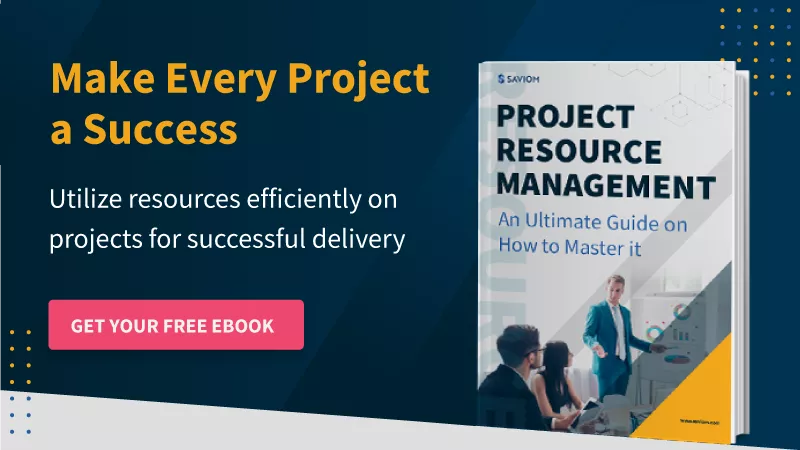Have you ever completed a project without encountering any setbacks?
Probably not. No matter how well-structured your processes are, obstacles are bound to arise. The real question is—what causes these setbacks, and why do they even surface in the first place?
Project management is an amalgamation of structured steps carried out in a sequential manner to ensure successful execution and delivery. However, with so many moving parts, project managers often juggle multiple responsibilities. Amidst tight deadlines and high expectations, they can unknowingly make mistakes.
These project management mistakes may seem insignificant at first, but they can quickly escalate into major roadblocks, leading to delays or even project failure. That’s why it’s crucial to recognize these mistakes early and take proactive steps to prevent them.
This blog explores the most common project management mistakes, their consequences, and practical strategies to fix them before they derail your project.
Let’s jump in…
Common Project Management Mistakes that Can Hinder the Success
Here’s a rundown of critical project management mistakes a project manager must avoid for timely and successful delivery:
Not Defining Project Scope & Goals Clearly
A project scope gives a precise overview of the key deliverables, ensuring successful execution and completion. Not defining the scope can lead to inaccurate resource estimation, missed milestones, and compromised project quality. It can also lead to ambiguities in understanding the individual roles and responsibilities. All these factors can cumulatively cause budget overruns, misalignment in deliverables and clients’ expectations, and hamper the project delivery.
Read More: What is a Project Scope? Benefits, Best Practices, and Steps to Create an Effective One
Inadequate Project Planning & Scheduling
One of the most common project management mistakes is inadequate planning and scheduling. In some cases, project managers underestimate the complexity of tasks or fail to account for dependencies, causing delays. Moreover, teams struggle to prioritize work without a proper project plan, leading to frequent bottlenecks and an overall lack of direction. Poor scheduling further amplifies these issues by creating unrealistic expectations and overwhelming teams with unmanageable workloads.
Incorrect Selection of the Project Management Methodology
Choosing the wrong methodology is a critical project management mistake that often results from a lack of understanding of project needs, stakeholder expectations, and team capabilities. For instance, a linear methodology like Waterfall may slow down projects requiring flexibility, while an Agile approach may cause chaos in projects requiring strict structure and documentation. This misalignment often results in poor collaboration, missed deadlines, and constant rework as teams struggle to adapt to an unsuitable framework.
Read More: Top 14 Project Management Methodologies: Tips to Choose the Right One
Inefficient Resource Planning and Allocation
Improper resource planning and allocation is a significant project management mistake that can severely impact team productivity and project outcomes. Poor resource planning can lead to issues like skill shortages and last-minute hiring, escalating the project budget. Similarly, incompetent resource allocation can lead to skill mismatches or scheduling conflicts. This can result in team members either feeling overwhelmed or disengaged. As a result, inefficient planning and allocation can undermine team performance and compromise project quality.
Excessive Reliance on Individual Excellence
Project managers are sometimes biased towards high performers they have worked with before and assign them critical responsibilities, leaving insufficient tasks for others. This leads to workload imbalances and fewer opportunities for other team members. Moreover, the project flow gets disrupted if these key individuals take unplanned leave or resign unexpectedly. Besides, when the project manager emphasizes only specific resources, the other team members may feel less valued. It can lower their morale and confidence, affecting the team’s cohesiveness and productivity.
Read More: 7 Powerful Insights on Sustaining High-Performance Work Teams
Inability to Manage Scope Creep
One of the prominent project management mistakes managers make is starting a project without a scope management plan. It can result in scope creep., which occurs when additional changes are introduced without proper evaluation or approval. As stakeholders request modifications, project managers may struggle to push back or assess the impact of these changes, leading to an ever-expanding workload. Without clear scope boundaries, teams face mounting pressure, resulting in missed deadlines, budget overruns, and resource exhaustion.
Lack of Proper Stakeholder Management
Another project management mistake is failing to engage stakeholders effectively throughout the lifecycle. When project stakeholders are not informed or consulted for pressing matters, the project manager has to convey everything all at once at the last minute. This rushed approach causes chaos, disrupts the workflow, and can lead to missed deadlines and loss of stakeholder confidence.
Read More: Who are the Project Stakeholders? 7 Effective Ways to Manage Them
Inefficient Team Communication and Collaboration
One of the most common project management mistakes is failing to establish clear and structured communication in the team. Without proper communication channels, team members may work in silos, duplicate efforts, or overlook critical tasks, ultimately affecting project outcomes. Furthermore, when updates, feedback, and key decisions are not effectively communicated, teams struggle to stay on the same page, leading to frustration and a higher risk of project failure.
Absence of Proper Risk Management Framework
The project involves inherent risks, such as scope creep, skill shortages, unplanned attrition, budget/schedule overruns, etc. When managers fail to create and follow a standardized risk management framework, these risks become issues, creating obstacles to project completion. Thus, failing to develop a risk mitigation plan upfront is a significant project management mistake that can jeopardize execution and delivery.
Read More: Enterprise Risk Management Framework: 8 Core Components
Ignoring Constructive Feedback
Overlooking constructive feedback from team members, stakeholders, or clients is one of the critical project management mistakes that can lead to missed opportunities for improvement. Additionally, when managers fail to gather valuable input, it can let emerging issues go unnoticed, resulting in repeated mistakes, subpar outcomes, and misalignment with expectations.
Now that you are familiar with common project management mistakes and their impact, let’s look at the ways to avoid them.
How to Avoid These Project Management Mistakes?
It is evident that some project management mistakes can have significant repercussions on the final project delivery. So, it is crucial to understand how to avoid these pitfalls and prevent a project failure.
Here are some proven tips project managers can implement to avoid roadblocks and drive success.
Create a Detailed Project Scope Statement
Establishing a comprehensive project scope statement helps set clear boundaries and expectations, allowing the team to align their efforts with project goals for successful delivery. This document outlines the project objectives, key processes, exclusions, assumptions, and acceptance criteria to facilitate seamless execution and completion.
Furthermore, it’s crucial to involve key stakeholders early on. This ensures that every requirement for an effective scope statement is meticulously documented, validated, and approved. Lastly, the scope statement serves as a reference point for managers to efficiently track progress, identify variances early, and take corrective action as needed.
Develop a Proper Project Plan and Schedule
A well-structured project plan clearly outlines the scope, resource requirements, timeline & budget, potential risks, communication channels, etc. This clarity makes it easier for team members to understand the project’s goals, priorities, and task interdependencies. Thus, it enables the team to work with a shared mission, minimizing misalignment, confusion, and unnecessary errors.
Furthermore, when there is a proper plan in place, managers can proactively address resource shortages, ensuring that necessary skill sets are available for execution within an estimated budget. This structured approach ensures that the projects are completed within the predefined project constraints and upholds set quality standards and stakeholder expectations.
Read More: What is a Project Plan & How to Create an Effective One?
Consider Project Traits from Lessons Learned to Choose the Right Method
A project management methodology combines various practices, principles, and techniques to ensure optimum project performance. Thus, managers should thoroughly assess the project’s requirements, objectives, characteristics, and team structure and evaluate lesson-learned reports before selecting the appropriate methodology.
Choosing the correct method prevents project management mistakes that stem from inappropriate approaches and provides numerous benefits. First, it helps define standard protocols and practices for project execution and keeps the team on the same page. Second, it allows flexibility to accommodate necessary changes seamlessly and effectively combat various resource risks and challenges.
Evaluate Project Needs and Create a Robust Resource Plan
To avoid project management mistakes such as skill shortages and workload imbalances, it is crucial for managers to thoroughly assess project needs and estimate resource requirements. This involves analyzing deliverables, dependencies, estimated efforts, and cost implications for both human and material resources.
In addition, managers can conduct a capacity vs. demand analysis to identify skill gaps and bridge them proactively by taking corrective measures like reallocating tasks, training existing team members, or hiring a contingent workforce. This in-depth evaluation helps create a well-defined resource plan that ensures that the right people and tools are available at the right time and cost.
Read More: What is Resource Planning, and Why is it Important in Project Management?
Follow an Effective Process-Dependent Delivery Approach
Instead of following the resource-dependent delivery approach, managers should keep it process-centric. This implies they won’t rely on just a handful of resources with high experience levels for various processes. Instead, they will equip every process with an appropriate mix of resources of varying levels of expertise and hierarchy.
So, when every process gets the right resource mix, it helps reduce excessive dependence on critical employees, amongst other benefits. Furthermore, it eases the burden on high performers, allowing them to focus efficiently on fewer tasks. Additionally, it provides less experienced employees with equal opportunities to contribute and showcase their potential.
Regularly Interact with CCB for any Scope Change
Though the project initiation document is finalized at the start of the project, a client may request modifications during the course of a project. In such a scenario, active tracking and discussion around scope changes are vital to prevent scope creep. While it is possible to accommodate minor changes easily, significant changes often need informed analysis.
Thus, managers should formulate a change management strategy outlining the impact of the ad hoc amendments and the necessary steps to incorporate them. This should be conveyed to the change control board (CCB), which is responsible for taking the final call after carefully evaluating the requested changes. If the board finds these changes feasible, managers can incorporate them into the project.
Read More: What is Change Management in Project Management, and Why Is It Important?
Keep the Stakeholders Engaged Throughout the Project Lifecycle
As discussed above, failing to engage stakeholders is a common project management mistake that can lead to misaligned expectations and resistance to change. To ensure seamless execution, project managers must involve stakeholders at every project lifecycle stage. This involves securing their buy-in from the outset to foster alignment.
In addition, managers can provide timely updates through tailored project reports, conduct period meetings to discuss progress, and address stakeholders’ concerns proactively. This helps reinforce their value to the project and build trust. Additionally, incorporating their feedback promptly assists in preventing last-minute changes, scope misalignment, and delays.
Establish Clear Communication and Foster Collaboration
To overcome project management mistakes related to poor communication, managers must focus on building a structured, transparent, and inclusive communication framework. This includes identifying key stakeholders and team members who need to be involved in project discussions and defining the type of information to be shared, its frequency, and the channels to be utilized.
Regular communication informs members of the project’s updates and conveys any pressing matters. Thus, this approach enables managers to gather their input regarding the project’s execution and ask if they face any specific challenges.Moreover, teams can utilize collaboration tools to ensure seamless project communication and real-time document sharing.
Read More: Why Project Communication Skills are Important and How to Master Them?
Develop a Risk Identification and Management Plan
It is vital for a project manager to formulate a robust risk assessment and mitigation plan right at the initiation stage. This starts by anticipating all the potential obstacles, such as skill shortages, project budget constraints, and unplanned attrition, to create a management strategy. Afterward, managers can leverage a risk matrix template to record risks and evaluate their severity and probability systematically.
The risk matrix not only gives a clear idea of associated risks but also helps categorize them into high-priority, medium-priority, and low-priority. After meticulously evaluating each risk, managers can build an effective action plan against each one. This plan ensures that reasonable control measures are implemented well in advance to minimize or negate the impact of risks.
Incorporate Feedback to Enhance Project Performance
Gathering and incorporating constructive feedback is key to generating tangible project outcomes. Managers can ensure quality deliverables by integrating a 360-degree feedback system, allowing constant collaboration and shared insights. To get started, managers can schedule periodic review meetings and solicit input from stakeholders and team members at key project stages.
This open discussion helps identify and resolve errors early. As a result, it enhances project performance and increases the likelihood of successful completion within the predefined time and budget. Moreover, addressing feedback promptly can prevent recurring issues such as misaligned expectations and overlooked risks, ensuring smoother and more efficient project execution and delivery.
Read More: 7 Proven Ways to Give Constructive Feedback to Your Employees
Now that we have explored how common project management mistakes can be avoided, let’s understand how resource management software can help.
How a Resource Management Tool Can Help Avoid Critical Mistakes & Ensure Success
By leveraging a futuristic resource management tool, managers can make informed, data-driven decisions and prevent common project management mistakes from impeding successful delivery:
- The tool’s all-in-one resource planner offers a multidimensional view of enterprise resources, enabling managers to slice and dice the data across various organizational dimensions like role, experience, skill, location, etc. This comprehensive visibility allows them to facilitate competent allocation.
- With intuitive forecasting capabilities, managers can gain visibility into pipeline projects and estimate the resources required. This way, they can avoid skill shortages and initiate projects on time.
- The embedded capacity planning feature allows firms to assess and bridge resource shortages/excesses. This prevents project management mistakes such as last-minute firefighting and expensive hiring.
- The software’s built-in competency matrix facilitates intelligent skill matchmaking. It allows organizations to evaluate resource competencies and prevent skill mismatches, resulting in high-quality deliverables and enhanced employee morale.
- The tool’s KPI forecaster provides valuable insights into key metrics like utilization, capacity, availability, and people on the bench. It enables them to make decisions and prevent project management mistakes such as burnout, underutilization, large bench size, etc.
- Using the software’s what-if scenario analysis, managers can create and compare various resource plans to identify the one that yields the best outcome.
Conclusion
Error-free project management and execution is a myth. After all, to err is human. Thus, project management mistakes are inevitable, but that doesn’t imply that they are unavoidable. By following the abovementioned strategies, project managers can act proactively and identify the pitfalls, helping them prevent a catastrophic effect on the project’s progress while ensuring successful project delivery.
So, what ways do you follow to avoid these project management mistakes?
The Glossary
Read More: Glossary of Resource Workforce Planning, Scheduling and Management












